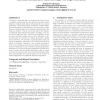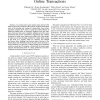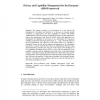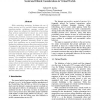618 search results - page 113 / 124 » Applying Distributed Object Technology to Network Planning |
KDD
2006
ACM
14 years 8 months ago
2006
ACM
Correlation clustering aims at grouping the data set into correlation clusters such that the objects in the same cluster exhibit a certain density and are all associated to a comm...
SECURWARE
2008
IEEE
14 years 1 months ago
2008
IEEE
— In current peer-to-peer systems users interact with unknown services and users for the purpose of online transactions such as file sharing and trading of commodities. Peer-to-...
SEMWEB
2007
Springer
14 years 1 months ago
2007
Springer
The natural evolution of eGovernment is to go beyond the management of identities and therefore it is necessary to manage people, companies or organizations, and their capabilities...
ADCOG
2004
13 years 9 months ago
2004
While networking technology facilitates the use of online services such as real-time instant messaging and anywhere-anytime multiplayer gaming, societal and ethical issues can inf...
DAIS
2001
13 years 9 months ago
2001
: Sentient Computing gives perception to computing systems so that they can detect, interpret and respond to changing aspects of users' context. The location attribute of a us...




